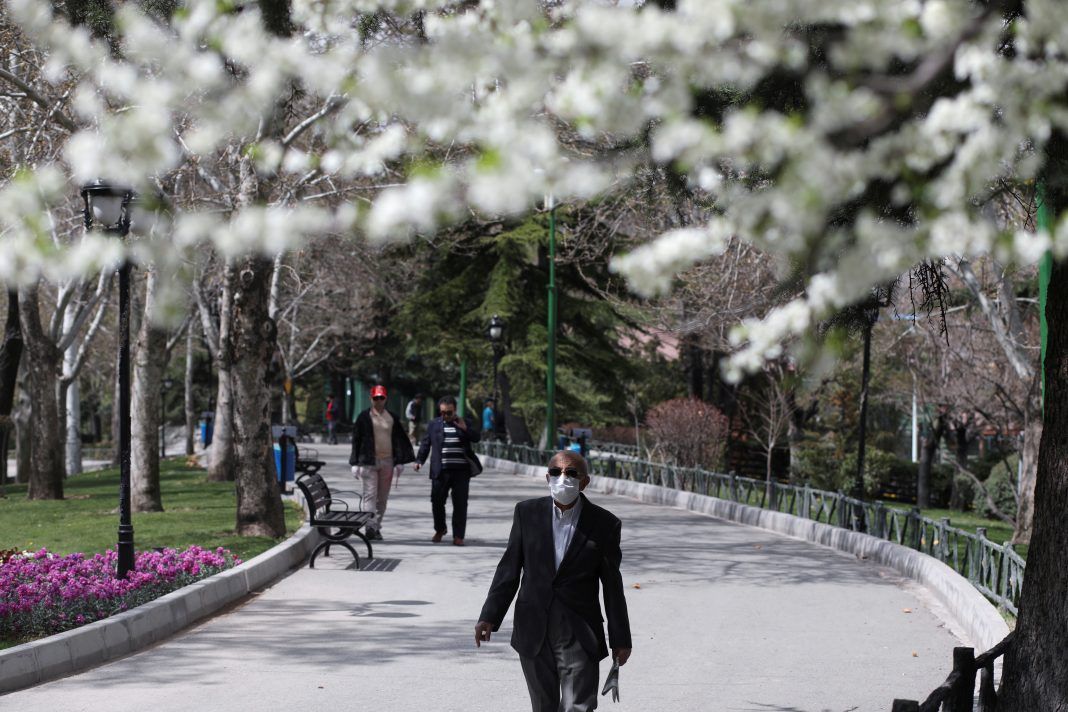By Nazanine Nouri
This week’s celebrations of the 13th day of Norouz — Sizdah Bedar — have been clouded by the Coronavirus outbreak in Iran, as millions of Iranians have been prevented from picnicking outdoors as they customarily do.
All parks and public spaces have been closed, and any breach of regulations is met with harsh penalties. This is all part of the social distancing and confinement measures that the Iranian government has introduced to combat the spread of the Covid-19 virus, which has contaminated tens of thousands of Iranians and led to thousands of deaths.
[aesop_image img=”https://kayhanlife.com/wp-content/uploads/2019/03/2020-03-26T134907Z_441845154_RC2PRF922TE2_RTRMADP_3_HEALTH-CORONAVIRUS-IRAN-scaled.jpg” panorama=”off” credit=”REUTERS./” align=”center” lightbox=”off” captionsrc=”custom” caption=”General view of a deserted street, during the intercity ban, amid fear of coronavirus disease (COVID-19), in Tehran, Iran March 26, 2020. ” captionposition=”left” revealfx=”off” overlay_revealfx=”off”]
[aesop_image img=”https://kayhanlife.com/wp-content/uploads/2019/04/2020-03-17T155324Z_1995893744_RC2RLF9ALFV9_RTRMADP_3_HEALTH-CORONAVIRUS-IRAN-scaled.jpg” panorama=”off” credit=”REUTERS./” align=”center” lightbox=”off” captionsrc=”custom” caption=”General view of an empty park, following the outbreak of coronavirus, in Tehran, Iran March 17, 2020. ” captionposition=”left” revealfx=”off” overlay_revealfx=”off”]
Here is how the tradition originated.
Sizdah Bedar — literally the “Thirteenth [Day] out of doors” — is celebrated on the 13th of the month of Farvardin. It is considered unlucky to stay home on that day, so fields, plains, parks and gardens are swarmed with families, young and old, who spend the day outdoors, preferably by a river or stream.
Sizdah Bedar is a day on which to celebrate nature. Iranians believe that by going outdoors, they welcome the spring, and leave behind all the bad luck associated with the number thirteen. (It is not clear when Iranians began to think of 13 as an unlucky number; it probably comes from the popular Muslim belief that the 13th day of the month is a day with unfortunate consequences.)
Before leaving the house, they disassemble the Sofreh-ye Haft Sin, the centerpiece of Nowruz — a special table with seven foods or items beginning with the letter ‘s’ in Persian. The sabzeh — or green sprouts grown especially for Nowruz and placed on the Haft Sin — are taken and thrown into a flowing stream of water, accompanied by a wish that any misfortune be washed away for the coming year. It is believed that the sabzeh embodies all of the inauspicious thoughts and feelings in a home, and disposing of it rids the household of bad luck and poor health.
Sizdeh Bedar celebrants then spread a carpet on the ground as a samovar brews fresh tea, celebrants enjoy a festive picnic, playing chess, backgammon, or cards, singing, dancing, and listening to music, chatting, or simply resting along the banks of the river. They can sometimes also be found playing Alak-Dolak (tip-cat): a game that is similar to baseball and played with wooden sticks. A bat (dolak) is used to strike a wooden peg (alak), then it’s recovered by fielders and thrown at the dolak placed on the ground.
[aesop_image img=”https://kayhanlife.com/wp-content/uploads/2019/03/Baliran_Jungle-Sizdah_Be-dar-13.jpg” panorama=”off” align=”center” lightbox=”off” caption=”FILE PHOTO: Sizdah Be-dar in the Baliran Jungle. Wikimedia Commons. Author: Mehdi. This file is licensed under the Creative Commons Attribution-Share Alike 3.0 Unported license. ” captionposition=”center” revealfx=”off” overlay_revealfx=”off”]
Unmarried girls pray for good fortune and success in finding a husband by knotting blades of grass in the fields and uttering the words:
Sal-I digar, Khane-I showhar, bachcheh dar baghal
(Let next year find me in my husband’s house with a baby in my arms)
Elaborate meals are prepared, and large quantities of fruits, nuts, and sweets are consumed. A favorite on this occasion is Ash-e Reshteh, a noodle soup made with chopped spinach and parsley, kidney beans, brown lentils, whey (kashk), and Iranian noodles or Reshteh. The noodles are said to symbolize good fortune for the New Year. Another favorite is Baghali Polo Ba Bareh or Persian Dill and Fava Bean Rice with lamb.
Sabzi khordan or fresh herbs including mint, tarragon and basil, radishes and spring onions serve as appetizers with flatbread and feta cheese. These green vegetables and herbs are central to the feast of Nowruz, and speak to its deeper significance: celebrating new life and the arrival of spring.
Sizdah Bedar has no religious connotation and is celebrated by all. It marks the end of the Nowruz festivities, and ends with the setting of the sun. Schools and offices re-open the following day, and life resumes, leaving behind the previous year’s bad occurrences, with a new and positive outlook for the coming year.


